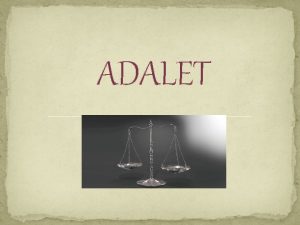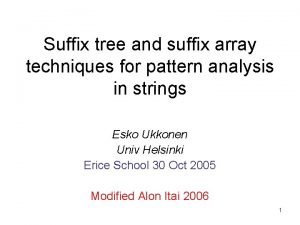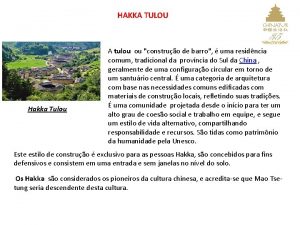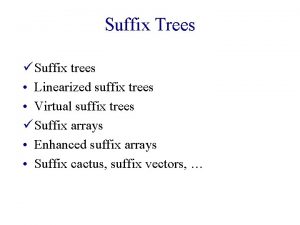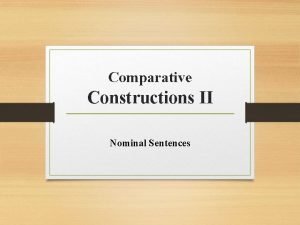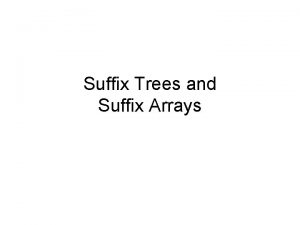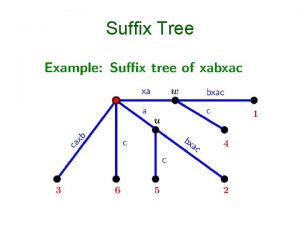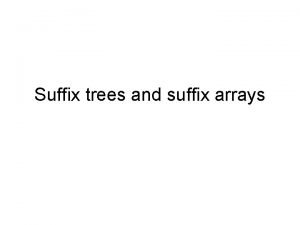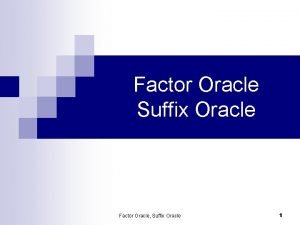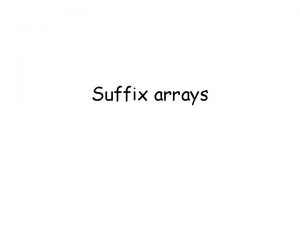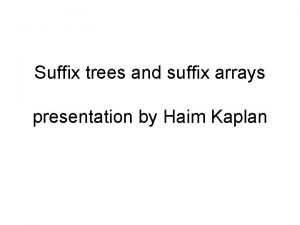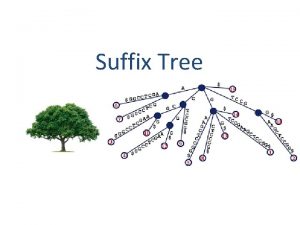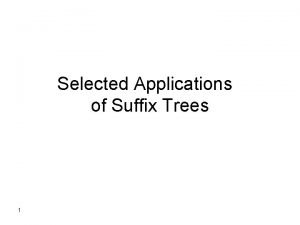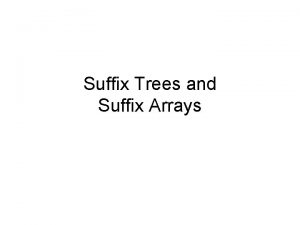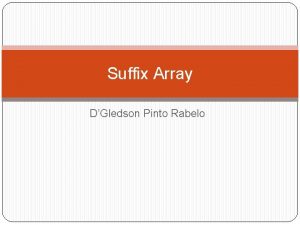Morphophonology of the Nominal Suffix in Taiwan Hakka













![Yangmei Hailu Onsets Bilabials Labiodentals Dentals Post-Alveolars Velars Glottals Ø [ʔ] 嬰矮 Unaspirated Voiceless Yangmei Hailu Onsets Bilabials Labiodentals Dentals Post-Alveolars Velars Glottals Ø [ʔ] 嬰矮 Unaspirated Voiceless](https://slidetodoc.com/presentation_image_h2/99b22b89fb2849cfeb0ead73ac0bd08e/image-14.jpg)



![Guanxi Sixian NS Root-Final Segment Suffix Form Examples [-p] /pl / /hap 8. pl Guanxi Sixian NS Root-Final Segment Suffix Form Examples [-p] /pl / /hap 8. pl](https://slidetodoc.com/presentation_image_h2/99b22b89fb2849cfeb0ead73ac0bd08e/image-18.jpg)
![Guanxi Sixian NS • Four surface forms: the syllabic lateral [l ], the syllabic Guanxi Sixian NS • Four surface forms: the syllabic lateral [l ], the syllabic](https://slidetodoc.com/presentation_image_h2/99b22b89fb2849cfeb0ead73ac0bd08e/image-19.jpg)






- Slides: 25

Morpho-phonology of the Nominal Suffix in Taiwan Hakka Dialects Michael M. Opper Phondi Talk 10/15/2010

Objectives • Talk about the phonological fundamentals of four Taiwan Hakka dialects • Compare the Nominal Suffix NS in Taiwan Hakka dialects with a particular emphasis on Guanxi Sixian

Hakka Dialects and Chinese • Hakka is one of seven Chinese languages • Spoken primarily in Northern Guangdong and Western Fujian • Roughly three million speakers in Taiwan; fifty million worldwide

Some Features of Hakka Dialects • All Hakka dialects have a nominalizing suffix. It is cognate to SC 兒 and has been commonly written with the “dummy character” 仔 • Lack [y] • Lack yángshǎng陽上; only one shǎng tone • Register distinction in píng and rù; sometimes qù • Words with sonorant initials in higher registers • Unique words for son ‘lai 6’ and mother ‘oi 1’

Taiwan Hakka Dialects • Sixian spoken by roughly 50% of Taiwan Hakka • Hailu spoken by more than 20% • Raoping spoken by less than 20% • Others spoken by less than 10%

Dialects Surveyed • • Zhutian Sixian Guanxi Sixian Xinzhu Raoping Yangmei Hailu

Taiwan Hakka Phonology • C(G)VX structure for heavy syllables • CV structure for light syllables (the NS) • Rimes (Finals) V: - {a, e, i, o, u, ɨ} VX- V {e, o, a}, X {i, u, p, t, k, m, n, ŋ} • Dialects differ mainly in Onsets (Initials) and Tonemes

Zhutian Sixian Onsets Bilabials Unaspirated Voiceless Stops Aspirated Voiceless Stops Labiodentals Dentals Velars Glottals p包冰 t刀等 k歌经 Ø [ʔ] 嬰有 pʰ 泡喷 tʰ同定 kʰ苦圈 Unaspirated Voiceless Affricates ts子走 Aspirated Voiceless Affricates tsʰ次在 f福 v碗 Fricatives Nasals Lateral Approximant m尾忘 s双船 n牛难 l梨流 h号限 ŋ饿元

Zhutian Sixian Tones 24 – MH 31 – ML 11 – LL X 44 HH 32 ML 55 HH

Guanxi Sixian Onsets Bilabials Unaspirated Voiceless Stops Aspirated Voiceless Stops Labiodentals Dentals Velars Glottals p包冰 t刀等 k歌经 Ø [ʔ] 嬰矮 pʰ 泡喷 tʰ 同定 kʰ 苦圈 Unaspirated Voiceless Affricates ts子走 Aspirated Voiceless Affricates tsʰ 次在 f福 v碗 Fricatives Nasals Lateral Approximant m尾忘 s双 z药 n牛难 l梨流 h号限 ŋ饿元

Guanxi Sixian Tones 24 – MH 31 – ML 11 – LL X 44 – HH 32 – ML 55 – HH

Xinzhu Raoping Onsets Bilabials Unaspirated Voiceless Stops Aspirated Voiceless Stops Labiodentals Dentals Velars Glottals p包冰 t刀等 k歌经 Ø [ʔ] 嬰矮 pʰ 泡喷 tʰ 同定 kʰ 苦圈 Unaspirated Voiceless Affricates ts子走 Aspirated Voiceless Affricates tsʰ 次在 f福水 v忘 Fricatives Nasals Lateral Approximant m尾 s四 z蛳 n牛难 l梨流 h号限 ŋ饿元

Xinzhu Raoping Tones 11 – LL 53 – HM 55 – HH X 33 – MM 44 – HH 31 – ML
![Yangmei Hailu Onsets Bilabials Labiodentals Dentals PostAlveolars Velars Glottals Ø ʔ 嬰矮 Unaspirated Voiceless Yangmei Hailu Onsets Bilabials Labiodentals Dentals Post-Alveolars Velars Glottals Ø [ʔ] 嬰矮 Unaspirated Voiceless](https://slidetodoc.com/presentation_image_h2/99b22b89fb2849cfeb0ead73ac0bd08e/image-14.jpg)
Yangmei Hailu Onsets Bilabials Labiodentals Dentals Post-Alveolars Velars Glottals Ø [ʔ] 嬰矮 Unaspirated Voiceless Stops p包冰 t刀等 k歌经 Aspirated Voiceless Stops pʰ 泡喷 tʰ 同定 kʰ 苦圈 Unaspirated Voiceless Affricates ts子走 tʃ张 Aspirated Voiceless Affricates tsʰ 次在 tʃʰ 抽 s四伞 ʃ食 ʒ有 f福 v忘 Fricatives Nasals Lateral Approximant m尾 n牛难 l梨流 h号限 ŋ饿元

Yangmei Hailu Tones 53 – HM 55 – HH 13 – 21 – ML LM X 33 – MM 55 – HH 32 – ML

The Nominal Suffix NS • Heavy syllables: CVX, Light syllables (such as the NS): CV • CVXCV will either have an unparsed syllable (CVX)CV or an ill-formed foot (CVX)(CV). • The NS cannot be a prosodic word, it affixes to a phonological word to avoid foot -based requirements • Requires an onset

The Nominal Suffix NS • Always e² in Zhutian Sixian (Common Sixian suffix) *** add examples • ɤ in Xinzhu Raoping and Yangmei Hailu, becomes a syllabic nasal following nasals with the same place of articulation *** add examples • Underlying /l/ in Guanxi Sixian
![Guanxi Sixian NS RootFinal Segment Suffix Form Examples p pl hap 8 pl Guanxi Sixian NS Root-Final Segment Suffix Form Examples [-p] /pl / /hap 8. pl](https://slidetodoc.com/presentation_image_h2/99b22b89fb2849cfeb0ead73ac0bd08e/image-18.jpg)
Guanxi Sixian NS Root-Final Segment Suffix Form Examples [-p] /pl / /hap 8. pl / ‘box’ [-t] /tl / /mat 7. tl / ‘socks’ [-k] /kl / /kok 8. kl / ‘rice patty’ [-m] /mɤ/ /zit 8. tjam 3. mɤ/ ‘a little bit’ [-n] /nɤ/ /mun 1. nɤ/ ‘mosquito’; /se 5. ŋin 2. nɤ/ ‘child’ [-n] /n / /lan 2. n / ‘basket’ [-ŋ] /ŋ / /kʰwai 5. tʰoŋ1. ŋ / ‘chopsticks box’ [ŋ ] /ŋɤ/ /ŋ 2. ŋɤ/ ‘fish’ [-i] /jŋ / /pʰi 1. jŋ / ‘quilt’; /mi 1. tʰjoi 5. jŋ / ‘rice bag’; /tʰjoi 5. jŋ / ‘belt’ [-i] /jɤ/ /pwoi 1. jɤ/ ‘heat rash’ /moi 5. jɤ/ ‘woman’ [-i] /jl / /koi 5. jl / ‘scab’; /kʰwai 5. jl / ‘chopsticks’; /lai 2. jl / ‘son’ [-a] /l / /tsaː 1. l / ‘car’ [-o] /wl / /tjao 5. wl / ‘bird’ [-u] /wŋ / /hu 1. wŋ / ‘beard’ ***switch bracket types
![Guanxi Sixian NS Four surface forms the syllabic lateral l the syllabic Guanxi Sixian NS • Four surface forms: the syllabic lateral [l ], the syllabic](https://slidetodoc.com/presentation_image_h2/99b22b89fb2849cfeb0ead73ac0bd08e/image-19.jpg)
Guanxi Sixian NS • Four surface forms: the syllabic lateral [l ], the syllabic dental nasal [n ], the syllabic velar nasal [ŋ ] and the mid-high back unrounded vowel [ɤ]. • I hypothesize that the underlying form is /l/, only surfaces unchanged in a specific environment: after [aː]: e. g. /tsʰaː+l/ [tsʰaː. l ]

Guanxi Sixian NS • Vowel final roots show a remarkable amount of free variation. • Spreading of the non-low vowels: e. g. /tjao-l/ [tjao. wl ] and /koi-l/ [koi. jl ]. • In some forms, the /l/ becomes [ŋ ]: e. g. /pʰi. jŋ /. • the /l/ becomes the back vowel [ɤ]: e. g. /pwoi. jɤ/ • Since /a/ has no glide counterpart, there is a ban on epenthesis, and there is a strict adherence to right-alignment of roots with syllables, [tsʰaː. l ] is the only option.

Gemination • There is a strong pressure for every syllable to have an onset. • There is also a strong pressure for the rightmost segment of every root to be aligned with the right edge of a syllable.

Constraints for Geminates onset dep Every syllable must have an onset The right edge of every root must align with the right edge of some syllable. Do not epenthesize *gem Do not have geminates align-R(Root, )

Constraints for hap. pl (con’t) /hap-l/ ☞ onset align-R dep max (a) hap. pl (b) hap. l (c) haː. pl (d) hap. lɤ (e) hap *gem * *! *!

Constraint Variation for Nasals /mun-l/ align-R (a) mun. n ☞ onset max *! *gem * (b) mun. nɤ (c) muː. nn dep * *! * * (d) mun *! /mun-l/ ☞ align-R dep max (a) mun. n (b) mun. nɤ (c) muː. nn (d) mun *! onset *gem * *!

Explain that these variants occur because of confusion from the dialects
 Hz ömerin adaletine örnek
Hz ömerin adaletine örnek Shlok desai
Shlok desai Dynasty of vijayanagara empire
Dynasty of vijayanagara empire Hakka ancestry
Hakka ancestry Suffix array python
Suffix array python Thể thơ truyền thống
Thể thơ truyền thống Sự nuôi và dạy con của hổ
Sự nuôi và dạy con của hổ Thế nào là hệ số cao nhất
Thế nào là hệ số cao nhất Diễn thế sinh thái là
Diễn thế sinh thái là Vẽ hình chiếu vuông góc của vật thể sau
Vẽ hình chiếu vuông góc của vật thể sau Slidetodoc
Slidetodoc Làm thế nào để 102-1=99
Làm thế nào để 102-1=99 Thế nào là mạng điện lắp đặt kiểu nổi
Thế nào là mạng điện lắp đặt kiểu nổi Lời thề hippocrates
Lời thề hippocrates Chụp phim tư thế worms-breton
Chụp phim tư thế worms-breton đại từ thay thế
đại từ thay thế Vẽ hình chiếu đứng bằng cạnh của vật thể
Vẽ hình chiếu đứng bằng cạnh của vật thể Quá trình desamine hóa có thể tạo ra
Quá trình desamine hóa có thể tạo ra Công thức tính độ biến thiên đông lượng
Công thức tính độ biến thiên đông lượng Sự nuôi và dạy con của hổ
Sự nuôi và dạy con của hổ Các châu lục và đại dương trên thế giới
Các châu lục và đại dương trên thế giới Dạng đột biến một nhiễm là
Dạng đột biến một nhiễm là Nguyên nhân của sự mỏi cơ sinh 8
Nguyên nhân của sự mỏi cơ sinh 8 Bổ thể
Bổ thể Phản ứng thế ankan
Phản ứng thế ankan Thiếu nhi thế giới liên hoan
Thiếu nhi thế giới liên hoan
